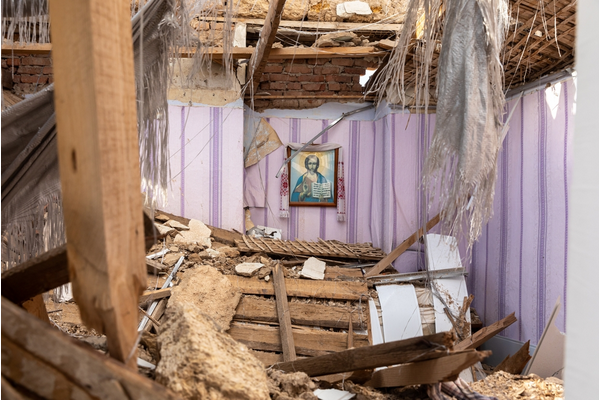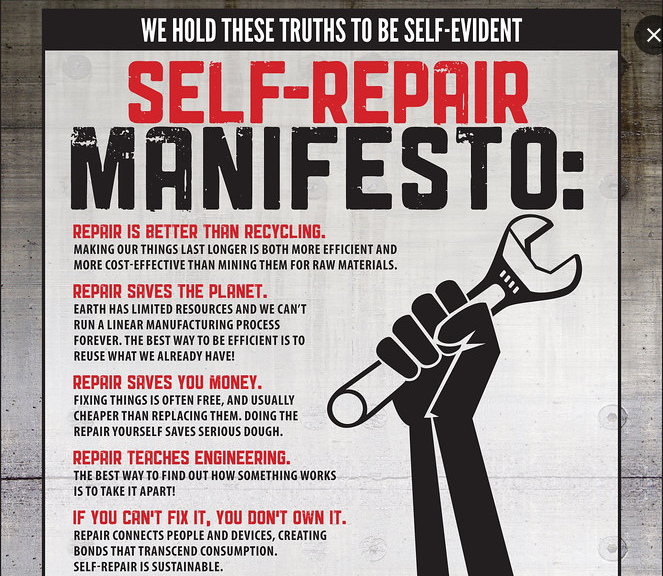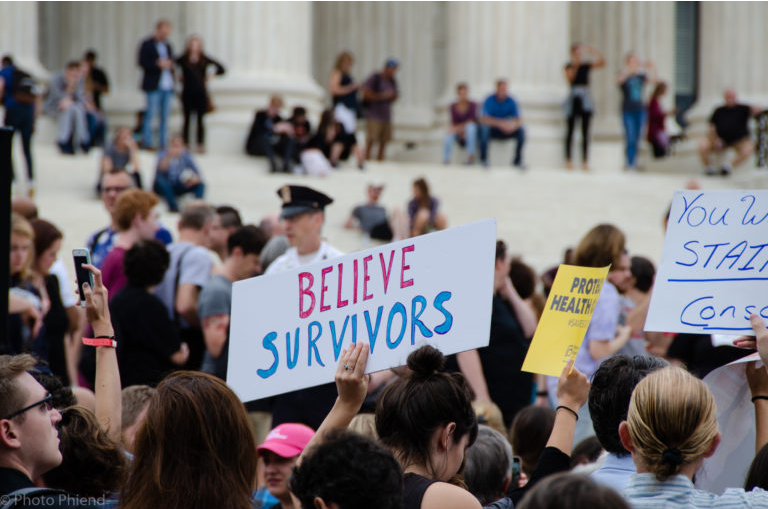


Green Consumerism: Between Ambition and Action
21 September 2023
Global Opinion on Climate Change
21 September 2023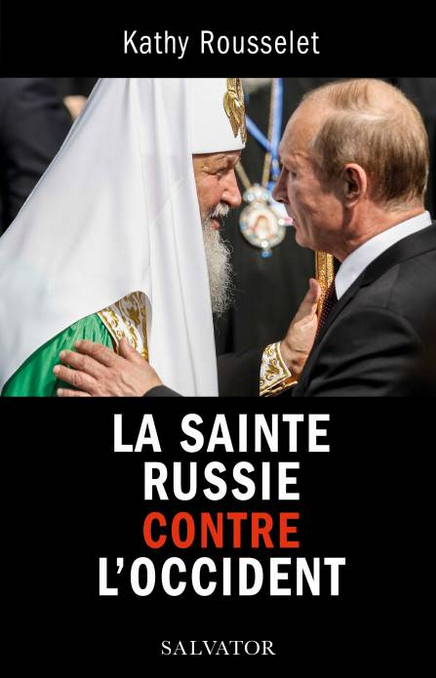 In her latest book, ‘Holy Russia versus the West’ (‘La Sainte Russie contre l’Occident’), CERI research director Kathy Rousselet examines the relationship between the Russian Orthodox Church, the Kremlin, and Russian society. In the process, she invites readers to go beyond the image of Patriarch Kirill supporting the war against Ukraine and promising absolution of the sins of any fallen soldier on the front line of this quasi-crusade. While Kirill champions Putin’s ultra-conservative positions, accusing the West of all evils, the relationship between Church, power and society in Russia is not unambiguous. Interview.
In her latest book, ‘Holy Russia versus the West’ (‘La Sainte Russie contre l’Occident’), CERI research director Kathy Rousselet examines the relationship between the Russian Orthodox Church, the Kremlin, and Russian society. In the process, she invites readers to go beyond the image of Patriarch Kirill supporting the war against Ukraine and promising absolution of the sins of any fallen soldier on the front line of this quasi-crusade. While Kirill champions Putin’s ultra-conservative positions, accusing the West of all evils, the relationship between Church, power and society in Russia is not unambiguous. Interview.
Corinne Deloy: How did this book come about, and what drove you to write it?
Kathy Rousselet: Over the past few years, I’ve been closely following relations between the Moscow Patriarchate (which is also the Patriarchate of ‘all Rus’) and political power: I carried out surveys in Russian parishes and interviewed many religious clerics. I became aware of the complexity of relations between politics and religion, but also of the multitudes contained within the Russian Orthodox Church. From this perspective, I analysed the homilies and speeches of Patriarch Kirill and other Russian Church clerics since the start of the war in Ukraine in 2022. With this book, I wanted to explain why the development of Orthodox religion went from being a harbinger of Russia’s opening to the West in the 1980s to becoming a force pitting Russia against the West.
More generally, I wanted to raise awareness about the Russian Orthodox Church. It is important to note that the church is also present in Western Europe, particularly in France.
C.D. : Can you give us an overview of relations between the Orthodox Church and the State during the Soviet period?
K.R.: The period was marked by state atheism, religious persecution and the destruction of religious heritage. The Russian Orthodox Church was tarnished by its leaders’ compromise with the authorities in what came to be known as ‘Sergianism,’ after Metropolitan Sergius (a future Patriarch) declared in 1927: ‘the Soviet Union as our civil motherland, whose joys and successes are our joys and successes and whose failures are our failures. Any blow directed at the Union […] is recognised by us as a blow directed at us.’
The Church largely owed its survival to the patriotic sentiment it officially channelled. From the late 1950s, the Orthodox Church hierarchy was called upon to promote world peace; when Orthodox Christians were persecuted, it played a role in Soviet diplomacy, notably in the international peace movement and the World Council of Churches.
However, the Russian Orthodox Church cannot be reduced to its hierarchy. Nor can its history be reduced to its compromises with power. Laypeople and clergy have tried to resist. Much has been said in the West about religious dissidents, particularly Father Gleb Yakunin. Although the Church was largely cut off from Soviet society, new research into social history shows how religious practices continued.
C.D. : How has the Orthodox Church in Russia evolved since Putin came to power in 2000?
K. R.: According to the 1993 Constitution, the Russian state is officially a secular state. Amendments made in 2020 did not fundamentally change this, even though they refer to the memory of ancestors who passed down ideals and faith in God. This does not mean that all religions are equal. Russia is a multiethnic and multi-religious state(1)In a Levada Center survey in April 2022, 71% of respondents identified as Orthodox, 5% as Muslim and 3% as Catholic, Protestant or Buddhist. See more here. , but the preamble to the law on freedom of conscience and religious organisations adopted in 1997 recognises, ‘the special role of Orthodoxy in the history of Russia, and in the evolution and development of its spirituality and culture’. The Russian Orthodox Church has become the main religious establishment with which various administrations maintain relations. It receives the most subsidies. And the authorities distinguish between ‘traditional’ and ‘non-traditional’ religions.
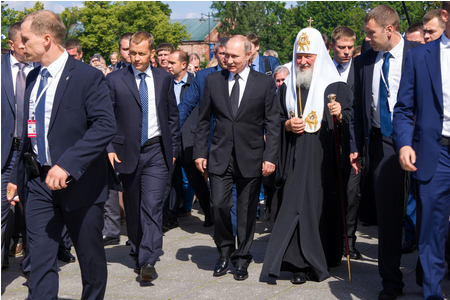
Kronstadt, Russia, July 30, 2017, Vladimir Putin and Patriarch Kirill. Photo: Oleg Kuleshov for Shutterstock.
Since Vladimir Putin came to power, the state has found symbolic support in the Russian Orthodox Church. During the Soviet era, authorities used atheism to promote ‘spiritual and moral values’ deemed essential to the edification of the Soviet people. After 1991, and particularly with Vladimir Putin, the Russian Orthodox Church was used to foster spiritual and moral values. The Russian president sees religion in continuity with communism. In exchange for special treatment, the Church has been given the means to rebound; it has won a number of cases, such as the restitution of ecclesiastical property that belonged to the State or municipalities, and the teaching of religion in schools. The political, economic and religious elites are closely linked.
Despite the Church’s apparent presence in the political arena, in a December 2021 poll asking Russians about the most authoritative people in the country, Kirill did not make the cut. Very few Orthodox Christians are churchgoers. The Church’s influence on society remains weak. Finally, in a Russia subject to increasingly authoritarian rule, the Church has little autonomy.
C.D.: You speak of fears of military conflict among some Orthodox Christians arising after the creation of the Church of Ukraine in 2018(2)Father Kotchetkov is the founder of the Saint-Philaret Institute, which is part of a liberal and modernizing movement in the Orthodox Church.. Can you go over this development?
K. R.: In the 1990s, there were several Orthodox Churches in Ukraine, only one of which was recognised by all the Orthodox Churches: the Ukrainian Orthodox Church under the Moscow Patriarchate. After the Orange Revolution of 2004–2005 and the Euromaidan of 2013–2014, Ukrainian political authorities felt that Ukraine’s political independence had to go hand in hand with religious independence. The idea of creating an autocephalous church, first raised in the early 1990s,
gained traction. For Petro Poroshenko, who was president of Ukraine before Volodymyr Zelensky, it was a national security issue. In 2018, two years after the Pan-Orthodox Council of Crete, which was shunned by the Russian Church, the Patriarchate of Constantinople decided to support the idea of an autocephalous church; in early 2019, it granted autocephaly to a new Orthodox Church: the Orthodox Church of Ukraine.
For the Moscow Patriarchate, which sees itself as a competitor of the Patriarchate of Constantinople, and for which Ukraine is part of what it calls ‘Holy Russia’, this was a gut punch. Financial considerations also evidently played a role in this decision, given the Ukrainian Church’s significant share of the Moscow Patriarchate’s parishes (at the start of the 2022 war, it accounted for more than a third).
In his address on February 21, 2022, Vladimir Putin cast what the Patriarchate considers a ‘schism’ as another grievance against Ukraine; he insisted that Christians in the Moscow Patriarchate’s Ukrainian Orthodox Church were subject to discrimination. Both the Kremlin and the Patriarch saw U.S. interference in the creation of the new Church, as in the Maidan revolution.
C.D. : Vladimir Putin and Patriarch Kirill have similar views on Russia’s place in the world. What would you say about the latter?
K. R.: Since the early 2000s, Kirill and Vladimir Putin have been promoting the same idea of a multipolar world in which Russia has its own specific path. Kirill opposes globalisation of the liberal world and emphasises the importance of traditions.
Vladimir Putin’s and Kirill’s maps of the world are alike. The ‘Russian world’ that the Russian president sees as his zone of influence is of a piece with the canonical territory of the Russian Church, according to Kirill. This applies in particular to ‘Holy Russia’, which according to the Patriarch includes Russia, Ukraine, Belarus and Moldova. Between 2000 and 2010, both developed a policy of influence in the world extending far beyond the former Soviet space. They support each other.
However, Kirill’s agenda doesn’t exactly match that of Vladimir Putin: while the former elevates the heritage of ‘Holy Russia’, he has always maintained that religious borders do not necessarily align with political ones. For example, he did not approve the annexation of Crimea.
C.D. : How is the Orthodox Church engaged in what you call manufactured tradition?
K. R.: Beginning in the 2000s, and even more so in the decade that followed, authorities called on the Russian Orthodox Church to show that Russia had its own path that was not that of the West. This specific tradition was built in the context of debates on issues ranging from juvenile justice reform to domestic violence, the Pussy Riot affair, and the issue of ‘non-traditional sexual relations’.
At the start of his term, Vladimir Putin was very popular, but in 2011–2012 protests broke out against his reelection. He therefore latched on to a mobilising discourse. It was around social issues, cast in such a way as to pit Russia against a hostile West, that the government and the Church hierarchy created a conservative consensus. The LGBT+ issue was easy to leverage because the Russian population is intolerant of homosexuality. This explains the relentless focus on homosexuality as a symbol of a depraved West in the Ukrainian war.
C.D. : What position did Kirill take when the war in Ukraine broke out, and where does he stand on the conflict today?
K. R.: In his first speech, on February 24, 2022, the Patriarch called for peace, but he quickly changed his tune and radicalised. At first, he presented the war as a metaphysical conflict between Good and Evil – a means of fighting against globalisation and secularised liberal culture, epitomised by gay pride. In this civilisational conflict, he called for the preservation of traditional values to prevent an apocalyptic end of the world.
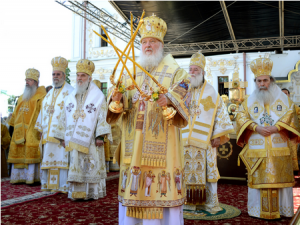
July 28, 2013, Patriarch Kirill and other bishops in kyiv celebrating the baptism of Rus. Photo: Marina Grigorivna for Shutterstock.
Just like the authorities, Kirill presents Russia as a besieged citadel, and the war in Ukraine as a defensive war. The theme of sacrificial feats also permeates Kirill’s comments, which hark back to Soviet patriotic rhetoric drawing on the memory of World War II. On September 25, 2022, he asserted that Russian soldiers who died in the war in Ukraine would be absolved of all their sins. We were a little quick to conclude that he was calling for a holy war.
Kirill’s comments need to be analysed in an ecclesial context marked by the powerful influence of ultranationalism. I’m thinking in particular of Tikhon Shevkunov, the Metropolitan of Pskov and Porkhov, who praised Putin in 2021 and regretted only one thing: that the Russian president is not immortal. Just after the start of the war, on Forgiveness Sunday, he explained the necessity of the war by echoing Putin’s rhetoric and speaking of the need to de-Nazify Ukraine. Tikhon Shevkunov, who is close to Vladimir Putin, could be a rival to Kirill in heading the Moscow Patriarchate.
The Patriarch’s speeches must also be understood in the context of the religious situation in Ukraine. While he calls for fighting Evil from the West, Kirill constantly brings up the ‘brotherhood of Rus peoples’. This discourse obviously endorses the ‘Russian world’ – Russia’s sphere of influence – but it also reflects an attempt to keep the Ukrainian Orthodox Church, which has increasingly detached from the Moscow Patriarchate during the war, in its fold. On May 27, 2022, this church proclaimed its ‘independence’. In the autumn of 2022, it chose to produce its own Holy Chrism(3)Holy Chrism is a mix of natural vegetable oil and perfumes, used for anointing in baptism, confirmation and ordination, which are sacraments, and in the consecration of a church or of its altar. as a way of claiming this independence. Given that the Ukrainian authorities consider it to be an agent of Moscow, the church is in survival mode. It has lost rights to use the Kiev Lavra Caves – a major Orthodox site founded in 1051 and home to more than 200 of its monks. The Orthodox Church of Ukraine now holds services there.
C.D. : Is there an anti-war movement within the Russian Orthodox Church?
K. R.: Yes. First of all, there is one in Ukraine, within the Ukrainian Orthodox Church, as I’ve just mentioned. The church has claimed its independence from the Moscow Patriarchate. Some priests have left it to join the Orthodox Church of Ukraine.
At the beginning of the conflict, a petition against the war was circulated within the Russian Orthodox Church. Around 300 priests from Russia and abroad signed it. An ecumenical peace declaration was posted on social networks on December 24, 2022. Most priests in Russia do not speak out publicly, if only because the war question divides families. Some asked to be relieved of their priestly duties. But it’s also important to understand that priests often have large families and few resources besides parishioner donations. In the West, parishes have left the Moscow Patriarchate. In the Baltic States, the opposition movement is quite visible and supported by political authorities.
Interview by Corinne Deloy, CERI, January 2023
Director of research at CERI and associate researcher at CERCEC (EHESS-CNRS), Kathy Rousselet mainly focuses on social and religious transformations in post-Soviet Russia. She is a member of the scientific committee of the International Observatory of Religions (CERI-GSRL, ). See her publications.
Further reading in French
The Russian-Ukrainian conflict: religious perspectives and issues (Le conflit russo-ukrainien : perspectives et enjeux religieux), Bulletin of the International Observatory of Religions, May 2023
Notes
| ↑1 | In a Levada Center survey in April 2022, 71% of respondents identified as Orthodox, 5% as Muslim and 3% as Catholic, Protestant or Buddhist. See more here. |
|---|---|
| ↑2 | Father Kotchetkov is the founder of the Saint-Philaret Institute, which is part of a liberal and modernizing movement in the Orthodox Church. |
| ↑3 | Holy Chrism is a mix of natural vegetable oil and perfumes, used for anointing in baptism, confirmation and ordination, which are sacraments, and in the consecration of a church or of its altar. |

